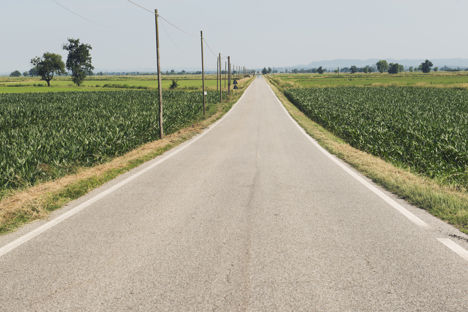
Cream of the crop: the risotto rice fields of Vercelli
Tom Riby talks to Gabriele Conte of gliAironi, an artisan Carnaroli rice producer based in Vercelli, Piedmont, and discovers a product that's much more than a staple ingredient.
Cream of the crop: the risotto rice fields of Vercelli
Tom Riby talks to Gabriele Conte of gliAironi, an artisan Carnaroli rice producer based in Vercelli, Piedmont, and discovers a product that's much more than a staple ingredient.
The environment is very important to the rice growers at gliAironi. Being based next to Italy’s largest colony of grey herons (which were nearly extinct in the 1980s due to the use of chemicals in agriculture) means they feel responsible for allowing nature to thrive around their rice fields. It’s thanks to a series of underground pipes, built in the 1950s, that gliAironi doesn’t have to rely on pesticides and weed killers to keep the water clean – creating a fantastic ecosystem in the process.
‘Most Italian rice is cultivated in Vercelli, which is the heart of European rice production,’ says Gabriele Conte, brand ambassador for gliAironi. ‘Our company has been there for 100 years, working alongside the canals that flood the rice fields and then empty out, marking the seasons and landscape of the region. We pay great attention to the environment around us, ensuring the wildlife can thrive and make sure everything is environmentally balanced.’
The type of rice traditionally grown in Italy is called japonica, which has rounder grains compared to other rice such as basmati. Even ninety percent of sushi rice eaten in Europe is grown in Italy. Risotto rice has the perfect balance of starches, which means the grain keeps its shape while cooking but releases a starch that, when combined with liquid, results in the creamy consistency that’s essential for good risotto. But growing the best rice needed is much more complicated than you might first think.
‘To grow the rice, we leave the ground to rest throughout winter until March,’ explains Gabriele. ‘Then we prepare the soil by levelling it with graders and lasers, before flooding the fields with water using our special canal and pipe system. In May, we sow the seeds in the water, using specially-equipped amphibious tractors, and over the next few months the flooded fields start to turn green as the plants grow. By late July when they finish flowering, the plants can be up to eighty centimetres high and the rice grains become starchy. The summer heat eventually evaporates all the water in the fields until it turns from milky to crystal clear, and throughout September and October we begin harvesting the rice.’
Working the rice fields in Vercelli means your day to day life changes drastically throughout the year. Harvest time is probably the busiest period, and having your fields flooded with water for half the year certainly changes how you tend to them. ‘Being a rice farmer is definitely more than just a job – it’s a lifestyle,’ says Gabriele. ‘You get to live in rhythm with the seasons and your daily routine changes depending on how the plants are growing.
‘Being a rice farmer in Italy has changed quite dramatically recently,’ he adds. ‘Until a few years ago, it was enough to inherit experience from the generation before you and respect the land and water. Now, it’s vital to have a good grasp of the demands of the global market, the laws surrounding it and the modern technology that makes agriculture such a cutting-edge area – we now use things like lasers and drones to farm rice!’
It’s new-fangled techniques like this that keeps growers like gliAironi at the top of their game, making sure they get the best yields possible and the quality of the rice is at its very best. But the main reason Vercelli has become so famous for its Carnaroli rice over the years is much more simple – the region’s soil. ‘The rice here is the best in the world because our soil is strong enough to prevent the water from being absorbed into the ground when we flood the fields,’ says Gabriele. ‘Different rice varieties prefer different soils; Carnaroli tends to be cultivated around Piedmont and Lombardy, whereas Vialone Nano comes from Veneto. We are based in Vercelli, which is full of small producers who have started to transform Carnaroli from a commodity crop into something truly excellent. Growers in places like Milan are more large-scale, going after quantity over quality. We want to do the opposite.’

